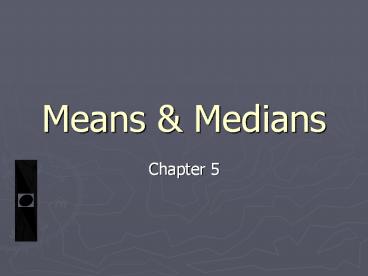Means - PowerPoint PPT Presentation
Title:
Means
Description:
Means & Medians Chapter 5 Parameter - Fixed value about a population Typical unknown Statistic - Value calculated from a sample Measures of Central Tendency Median ... – PowerPoint PPT presentation
Number of Views:194
Avg rating:3.0/5.0
Title: Means
1
Means Medians
- Chapter 5
2
Parameter -
- Fixed value about a population
- Typical unknown
3
Statistic -
- Value calculated from a sample
4
Measures of Central Tendency
- Median - the middle of the data 50th percentile
- Observations must be in numerical order
- Is the middle single value if n is odd
- The average of the middle two values if n is even
NOTE n denotes the sample size
5
Measures of Central Tendency
parameter
- Mean - the arithmetic average
- Use µ to represent a population mean
- Use x to represent a sample mean
statistic
- Formula
S is the capital Greek letter sigma it means to
sum the values that follow
6
Measures of Central Tendency
- Mode the observation that occurs the most often
- Can be more than one mode
- If all values occur only once there is no mode
- Not used as often as mean median
7
- Suppose we are interested in the number of
lollipops that are bought at a certain store. A
sample of 5 customers buys the following number
of lollipops. Find the median.
The numbers are in order n is odd so find the
middle observation.
The median is 4 lollipops!
2 3 4 8 12
8
- Suppose we have sample of 6 customers that buy
the following number of lollipops. The median is
The numbers are in order n is even so find
the middle two observations.
The median is 5 lollipops!
Now, average these two values.
5
2 3 4 6 8 12
9
- Suppose we have sample of 6 customers that buy
the following number of lollipops. Find the mean.
To find the mean number of lollipops add the
observations and divide by n.
2 3 4 6 8 12
10
Using the calculator . . .
11
- What would happen to the median mean if the 12
lollipops were 20?
5
The median is . . .
7.17
The mean is . . .
What happened?
2 3 4 6 8 20
12
- What would happen to the median mean if the 20
lollipops were 50?
5
The median is . . .
12.17
The mean is . . .
What happened?
2 3 4 6 8 50
13
Resistant -
- Statistics that are not affected by outliers
- Is the median resistant?
YES
NO
- Is the mean resistant?
14
Look at the following data set. Find the mean.
22 23 24 25 25 26 29 30
Now find how each observation deviates from the
mean. What is the sum of the deviations from the
mean?
Will this sum always equal zero?
YES
This is the deviation from the mean.
0
15
- Look at the following data set. Find the mean
median. - Mean
- Median
27
27
Create a histogram with the data. (use x-scale of
2) Then find the mean and median.
Look at the placement of the mean and median in
this symmetrical distribution.
21 23 23 24 25 25 26 26 26 27 27 27 27 28 30 30
30 31 32 32
16
- Look at the following data set. Find the mean
median. - Mean
- Median
28.176
25
Create a histogram with the data. (use x-scale of
8) Then find the mean and median.
Look at the placement of the mean and median in
this right skewed distribution.
22 29 28 22 24 25 28 21 25 23 24 23 26 36 38 62
23
17
- Look at the following data set. Find the mean
median. - Mean
- Median
54.588
58
Create a histogram with the data. Then find the
mean and median.
Look at the placement of the mean and median in
this skewed left distribution.
21 46 54 47 53 60 55 55 60 56 58 58 58 58 62 63
64
18
Recap
- In a symmetrical distribution, the mean and
median are equal. - In a skewed distribution, the mean is pulled in
the direction of the skewness. - In a symmetrical distribution, you should report
the mean! - In a skewed distribution, the median should be
reported as the measure of center!
19
Trimmed mean
- To calculate a trimmed mean
- Multiply the to trim by n
- Truncate that many observations from BOTH ends of
the distribution (when listed in order) - Calculate the mean with the shortened data set
20
- Find a 10 trimmed mean with the following data.
- 12 14 19 20 22 24 25 26 26 35
10(10) 1 So remove one observation from
each side!































